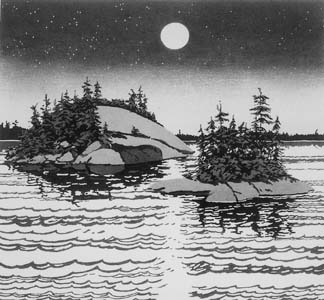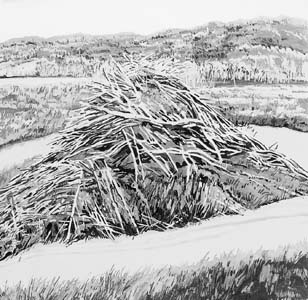![[MetroActive Arts]](/arts/gifs/art468.gif)
[ Arts Index | Santa Cruz Week | MetroActive Central | Archives ]
Hypnotic Whirls: Neil Welliver's woodcut 'Islands Allagash' is a collaboration with Shigemitsu Tsukaguchi.
Maine Attraction
Neil Welliver paints the woods and streams of Maine's Allagash wilderness with the controlled rage of a Zen master
By Christina Waters
A LUSH PORTION of Maine's rocks, streams and woodlands has been Neil Welliver's muse for three decades. Widely regarded as a landscape painter's landscape painter, Welliver is currently represented in a rare and substantial West Coast show at the Cabrillo Gallery.
Thanks to the tenacity of curator Terry Hogan--a Cabrillo instructor who took her MFA with Welliver at University of Pennsylvania--almost 20 works by a man considered one of America's finest contemporary landscape painters are gathered here.
A feast for devotées of realism, this vigorous collection represents the strengthening tide of inquiry that seeks to address the life-after-postmodernism future. The show reveals a quintessentially Eastern and hence distant landscape--certainly one that will appear alien to audiences weaned on redwoods and manzanita.
In small, 24-inch-by-24-inch oil studies--painted onsite and then dragged back to the studio for further aesthetic decoding--complex woodcuts and several large six-foot-square canvases, Welliver's obsession is laid bare.
He is a modernist through and through. You can practically feel his feet planting themselves on the muddy banks of New England streams. His shoulders shrug off mystery and inclement weather with equal vigor. If Hemingway had painted, one suspects he would have been Welliver.
Thick snow frosts gray granite in one piece, while in another, odalisques of birch bark reflect and refract into hypnotic whirls. From a distance, natural selection verges on pop art, and Welliver's shadowless compositions can mimic giant posterized graphics whimsically divorced from an environmental ad campaign.
Sometimes Welliver lets the trees, leaves and filtered sunlight grow quiet. As you watch these woods, you can feel your own witnessing dissolve. Welliver's woods don't need humans--they contain nothing of that Gothic anthropomorphism that preoccupied the 19th century. Whose woods these are, I think I know: no one's. Still, the canvas seems to breathe. The juicy paint lives on its own.
Just as there is no romanticism in Welliver's work, there is not a trace of irony. And this is all the more surprising since at first glance, his flat, bright palette and confident painterly gesture remind us of David Hockney without the sense of play.
We are supposed to be viewing a display of figurative landscape painting, yet the unmistakable impression of the show is that of abstract expressionism. Birch bark begins to decompose, to disintegrate before our eyes until the black gashes in the white bark start to float. After a moment, the trees themselves disappear, and we're left contemplating black-and-white patterns.
Welliver's deep-tissue abstraction is often the most powerful feature of his work--as when the cross-hatching of trees, reflected intricately in a pond, begins to weave and reweave at a level below that of names, objects and identifiable landmarks.
LIKE HIS TEACHER, Josef Albers--who obsessively explored the juxtaposition of colored squares--Welliver is drawn to the repeated rhythms of a landscape that appears to have devoured him. And his travels are no sentimental journey.
Bold and brash--yes. But more handsome than beautiful.
It's a true cliché that artwork is only really grasped when it's seen "live," rather than on a website or in glossy reproduction. And that's never been truer than with this show, where the brisk brushwork practically vibrates across the large canvas surfaces.
Even those familiar with Welliver's work (which belongs to permanent collections of the Whitney, Metropolitan, MoMA and Hirshhorn museums--will find new dialog occurring among Welliver's works.
Most bewitching, perhaps, is the bounty of handsomely framed woodcuts created by Japanese master Shigemitsu Tsukaguchi in collaboration with Welliver. Their decade-long partnership has resulted in pieces of mesmerizing complexity. Twenty-two separate blocks--all perfectly registered--went into one study of sky reflected in water. In another case, the curator located Welliver's pencil drawing, which now hangs next to the wood block it later became. The effect is to strip bare the very process of abstraction.
Small painted studies mounted next to their larger-scale offspring tell a similar tale. In viewing first one, then the other, we can observe the individualizing process of editing, selection, removal and emphasis. Welliver's editorial choices appear to favor craft over sensuality. That most of the works testify to the simplification, even neutralization of the messy vivacity of nature by the artist makes the few small exceptions all the more appealing.
Three 12-inch-by-12-inch pieces from the '70s and '80s show an immediacy, a lack of calculation that seems to have become compromised in later, more self-conscious pieces. Here, in a hushed palette, we glimpse the rocks and swirling water that Welliver so clearly loves. Like Zen exhalations they are complete unto themselves.
Not so the garish orange brushwork of Autumn Beaver House, a signature oversized canvas whose insistence jars the ambiance of the show. From a vantage point, this much-reproduced piece has an eerie wallpaper photo realism. But up close the urgent brush strokes reveal themselves as somehow brutal, occasionally eloquent.
It's a vital show, offering a rich opportunity to sample multiple genres and viewpoints on a single sustained vision. Devoid as they are of human subjects, Welliver's work can easily operate as Rorschachs--nonthreatening corporate art that pleases to the exact degree that it demurs.
So surface-intensive are the paintings that one of the Welliver myths circulating in the art world is how he stands in front of the 72-inch-by-72-inch canvas (everything is an homage to Albers' square) and beginning at the top left-hand corner paints in one continuous session all the way down to the bottom right-hand corner--one take.
The canvases are indeed a repository of gestural painting. No hesitation, no modulation. It would be easy to suspect that the Maine woods have little to do with any of it--that the wild heart of the rocks, streams and trees only provide the excuse for Welliver's ongoing meditation on paint.
There is something urgent about this work--save for the woodcuts, whose serenity is culturally borrowed. The painter, not the forest, seems haunted. Ceaselessly painting variation after variation of a place he returns to over and over, Welliver seems to be fleeing his date with whatever is waiting for him.
That avoidance has, of course, produced a wealth of intriguing artwork. The attempt to quell personal demons fuels each piece in the show. Whatever Neil Welliver has found in those Maine woods, it isn't peace.
Copyright © Metro Publishing Inc. Maintained by Boulevards New Media.
![]()

Photograph by Neil Welliver

Repository of Gestural Painting: Welliver's large works (like 'Autumn Beaver House,' above) strike the viewer without hesitation or modulation.
Neil Welliver: Contemporary American Landscapes. Through April 6 at the Cabrillo College Gallery. Monday-Friday 9am-4pm, also Monday and Tuesday, 7-9pm. Closed weekends. (831.479.6308)
From the March 15-22, 2000 issue of Metro Santa Cruz.